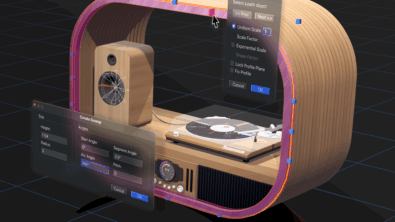D-Cubed geometric constraint solver used in Catchbook

 Siemens PLM Software recently announced the availability of Catchbook – a new app for converting freehand sketches into accurate 2D designs. The app makes very neat use of geometric constraint solving with D-Cubed 2D DCM. What distinguishes Catchbook from many other 2D DCM-enabled applications is the combined approach of bridging the gap between concept and CAD, while improving accessibility and collaboration with support for a wide range of mobile devices.
Siemens PLM Software recently announced the availability of Catchbook – a new app for converting freehand sketches into accurate 2D designs. The app makes very neat use of geometric constraint solving with D-Cubed 2D DCM. What distinguishes Catchbook from many other 2D DCM-enabled applications is the combined approach of bridging the gap between concept and CAD, while improving accessibility and collaboration with support for a wide range of mobile devices.
Bridging the gap between concept and CAD
Applications use D-Cubed 2D DCM to assign geometric constraints in a sketch – parallel lines, tangent arcs, equal radius circles, etc. These constraints express the overall design intent and facilitate rapid design changes by modifying specific parameters such as length/radius, or by interactive dragging.
Typically, users build sketches by selecting mathematically defined geometry types from a menu – lines, arcs, splines, etc. To make life easier for users, some systems infer relationships while the sketch is being constructed – for example, by automatically applying a perpendicular constraint when a new line is added at 90 degrees to an existing line.
Catchbook goes beyond this capability by letting users create or trace sketches freehand, using touch or stylus, reducing the need for menu interaction. Catchbook can infer the corresponding precise geometry and makes use of 2D DCM to apply appropriate constraints on-the-fly. Rough concepts quickly become accurate, CAD-compatible drawings, which are easy to modify and suitable for use in planning and construction.
Collaboration on mobile devices
Catchbook runs on Android, iOS and Windows mobile devices, so designers can make use of it anywhere – both online and offline. Critical to this capability is the 2D DCM’s high performance and small footprint as a component. Catchbook makes collaboration easy through sharing on social media, via email, or by exporting images/drawings for use in other design systems.

These are just some of the benefits that make Catchbook accessible to users with no experience of CAD, as well as professional designers who need to capture ideas and collaborate more easily with non-CAD users. For more information about Catchbook and the 2D DCM, use the links below.
Comments
Leave a Reply
You must be logged in to post a comment.



Catchbook and D-Cubed are in the news – there is nice interview with Ken Hosch and Paul Brown in the latest issue of the upFront eZine about Catchbook. In the article, Ken and Paul talk about how D-Cubed is used within this new innovative application from SIemens PLM.